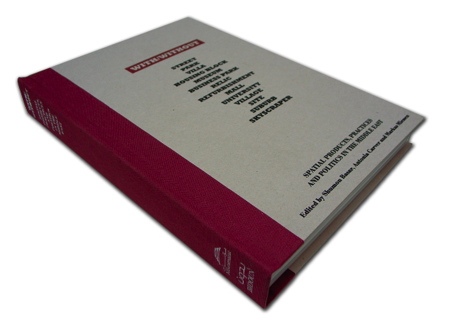
With/Without launched at IDF
Live from Dubai: A new book exploring architecture, design and urbanism in the Middle East has been launched at the International Design Forum.
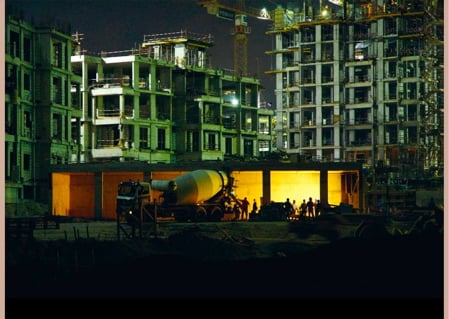
Called With/Without, the book contains a collection of critical essays discussing subjects ranging from the redevelopment of Martyr’s Square in Beirut; the residential “satellite cities" surrounding Cairo; gated communities in Istanbul; and the creation of a new Iraqi flag in the wake of the second Gulf War.
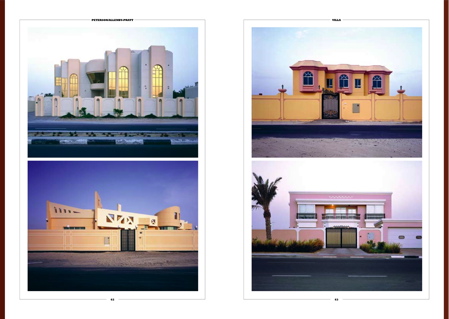
Subtitled “Spatial products, practicies and politics in the Middle East" and edited by Shumon Basar, Antonia Carver and Marcus Miessen, the book is published by Bidoun magazine and IDF organiser Moutamarat.
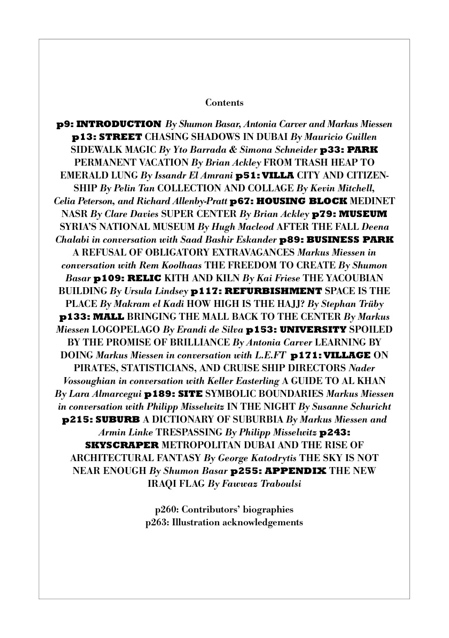
The book was launched at the IDF this weekend alongside Al Manakh, a study of architecture and urbanism in the Persian Gulf by AMO, Moutamarat and Archis.
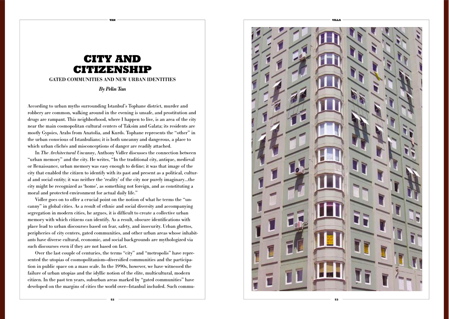
Reproduced below is the introduction from With/Without, while the press release follows after that:
--
With/Without:
Spatial products, practices and politics in the Middle East
Introduction
We’re always in the middle of something. Somewhere. Or some-time. It’s proof that everything is more connected than disconnected. Despite this, we have vocabularies that persistently designate divisions and rifts, fault-lines and borders. In language, time is bisected into the past and the future. The present is placed in between, like a temporal bridge, whose ends are impossible to discern. Perhaps words are to blame. Maybe words introduce stoppages, when otherwise we’d think in terms of continuities. Words can and do mark out spaces and territories.
Coinciding with the first ever International Design Forum (IDF) in Dubai, this book casts an eye across the broader swathes of the Middle East. It explores how spaces and territories form fundamental ideas about individuals, communities, and worlds. As everyone now knows, Dubai’s ambition is to become a truly global locus, liberated from any trenchant localism. In doing so, it has also come to represent an alternative twenty-first-century Middle Eastern reality that simultaneously ushers in radical capitalism while sustaining Islamic state identity. It’s a “slash" condition, as in “/". Not either/or, but both/and.
As Dubai builds an unprecedented realm of new newness—some of it new-old and old-new—other parts of the Middle East grapple with physical and symbolic histories again and again. Relics come against re-invention and revolution. Memory contests with an all-pervasive media presence. Micro-mutations in Middle Eastern politics or economics are part of our shared “local" news around the globe. We’re always all in the Middle, it seems, again and again. A middle that has taken to re-designing how it is perceived, as places that we consume for real or in real-time coverage.
Aesthetic or political values are enshrined in the words we all use, whether in Arabic or English or Farsi or Urdu. Classical dualities grounded in the bedrock of philosophy seem to recur throughout our languages: inside/outside, here/there, resident/alien, same/other. The title of this publication invokes another one of these plus/minus pairings: with/without. Depending on their context, both conditions—with or without—can be a potential asset. Or liability. In some slippery way, “with" and “without" are interchangeable words. Brought together—with the semiotic sealant of the slash—with/without presents a choice as well as a compound.
The subtitle of With/Without refers to “spatial products, practices, and politics." These three species of spaces are distinct yet intimately entwined. Spatial products refer to manufactured entities, such as buildings, public spaces, monuments, gardens, and transport infrastructures as well as the vehicles set upon them. Spatial practices describe an unwieldy cohort of professionals and amateurs whose work involves the imagining, configuring, or destruction of spaces. The most obvious would be the traditional city planner.
But we could add to this UN humanitarian relief agencies or legislators charged with dispensing new laws allowing special economic or social zones to exist within a nation state. Spatial politics make up the last category. Here, we’re gauging the ways in which spaces (often referred to as “territories"—occupied, contested, or otherwise) are an embedded instrument of political imagination or discourse. For many, design may take place in a conceptual bubble of the genius designer’s intentions. But the consequences of design become a province of human concern beyond aesthetic criteria alone.
Fourteen chapters make up a selective view of the Middle Eastern city as it is today. Each of the chapters takes an apparently obvious architectural or institutional typology (the museum, the villa, the street, the skyscraper, etcetera) and illustrates it with essays, interviews, and documentary photographs. Its content has been developed and curated partly from Bidoun magazine’s archive and partly through exclusive commissions for the book.
The idea is that you, as the reader, will move through the pages and in doing so, traverse geographic, symbolic, and ideological distances. Often, the spaces that have the greatest impact have no clear “star" designer behind them. Yet, they matter intractably. By de-emphasizing the author, we’re not trying to kill the star. But we believe that effect can often transcend cause—something that happens in the actual life of buildings and cities. This goes beyond the imaginations of the most gifted of architects and designers.
With/Without isn’t propaganda for or against what is happening in the Middle East today. Nor is it a triumphant declaration of love or loathing for what Dubai has come to represent. Literature on Dubai so far falls roughly into two categories: neo-liberal coffee-table gloss-dross or neo-left moralizing. Cultural critics tend to fall back onto unwitting neo-colonial accounts that hinder any constructive move forwards. Most certainly, some of the spatial/political practices evident are in need of critical interrogation and accountability.
But an unexamined Western paradigm can surely no longer be the ultimate measuring stick? Does “democracy" come pre-packaged like a Big MacTM? Recent events suggest the answer is a demonstrable “no." In emerging situations like Dubai, premature hyperbole should be avoided by critics. Ditto to over-determined doom. Fast, sweeping conclusions will be weighed down by our distinctly Western/Middle/Eastern cultural baggage. We must seek a plurality of positions that are as agile as they are inventive.
If design is to play a significant part in shaping the world outside the shop window, then we must investigate the world “without" design(ers) as much as the world “with" design(ers). Even though this part of the world exhibits and undergoes flux and mutability at an incredible rate and with amazing jump-cuts, history will be made by accumulating critical freeze-frames for us to look back on. And we’re back here again: in the middle somewhere.
- Shumon Basar, Antonia Carver, and Markus Miessen, editors
--
PRESS RELEASE: NEW PUBLICATION
May 27, 2007
WITH/WITHOUT
Spatial Products, Practices and Politics in the Middle East
Edited by Shumon Basar, Antonia Carver and Markus Miessen
Featuring: Mauricio Guillen, Yto Barrada & Simona Schneider, Brian Ackley, Issandr El Amrani, Pelin Tan, Richard Allenby-Pratt & Celia Peterson, Kevin Mitchell, Hugh Macleod, Deena Chalabi, Dr Saad Bashir Eskander, Rem Koolhaas, Kai Friese, Ursula Lindsey, Senan Abdelqader, Clare Davies, Stephan Trüby, Markus Miessen, Shumon Basar, Erandi de Silva, Antonia Carver, L.E.FT, Nader Vossoughian, Keller Easterling, Lara Almarcegui, Philipp Misselwitz, Susanne Schuricht, Armin Linke, George Katodrytis, Fawwaz Traboulsi
Designed by Jana Allerding, 9714
Published by Bidoun and Moutamarat on the occasion of the first International Design Forum, May 27-29, 2007
As Dubai builds unprecedented realms of new newness, other parts of the Middle East grapple with physical and symbolic histories. Relics come up against re-invention and revolution. Micro-mutations in Middle Eastern politics or economics are part of our shared ‘local’ news around the globe.
With/Without is an anthology that casts an eye across the broader swathes of the Middle East today. Featuring an innovative, archival design, this hardback book is essential reading for anyone interested in the social makeup, design and architecture of Middle Eastern cities.
Each of the fourteen chapters takes an obvious architectural or institutional typology (the museum, the villa, the street, the skyscraper, etcetera) and illustrates it with essays, interviews, and documentary photographs. The underlying question in all of these inquiries is: how do spaces and territories form fundamental ideas about individuals, communities, and worlds?
Co-published by Bidoun and Moutamarat, With/Without is edited by London-based architects/critics Shumon Basar and Markus Miessen, with Bidoun editor Antonia Carver, and designed by the award-winning Dubai agency 9714.
With/Without isn’t for or against what is ‘happening’ in the Middle East today. Nor is it a declaration of love or loathing for what Dubai has come to represent, globally speaking. As the world progresses into new social formations at the beginning of the 21st century, With/Without promotes a plurality of critical positions that are as agile as they are inventive.
For further information, images or review copies, please contact Antonia Carver, Bidoun (antmcarver[at]yahoo.co.uk or tel +971 50 454 6051) or Rebecca Brook, Moutamarat (rebecca.brook[at]moutamarat.com or +971 4 319 2180).
Notes to editors:
WITH/WITHOUT
Spatial Products, Practices and Politics in the Middle East
- is a Bidoun book co-published by Middle East arts organisation Bidoun (www.bidoun.com) and Moutamarat (www.moutamarat.com), a joint venture between Tatweer and the Saudi Research and Publishing Company that creates platforms for developing the knowledge agenda of the Arab world.
- is priced at $25 / Dhs90, and will be distributed via bookshops in the Middle East, Europe, UK and US.
- is the first publication to address “spatial products, practices, and politics in the Middle East." Spatial products connote manufactured entities, such as buildings, public spaces, monuments, and transport infrastructures. Spatial practices describe an unwieldy cohort of professionals and amateurs whose work requires the imagining, configuring, or destruction of spaces. Spatial politics describes the ways in which spaces (often referred to as “territories"—occupied, contested, or otherwise) are an embedded instrument of political imagination or discourse.
- was launched in Dubai at the International Design Forum, May 27, 2007. Held under the official patronage of H.H. Sheikh Hamdan bin Mohammed bin Rashed Al Maktoum, Chairman of the Executive Council of Dubai, from May 27 to 29, 2007, Moutamarat’s first annual International Design Forum (IDF) is built around three main programme tracks: Industrial Design, Urban Design and Design Connects. This exclusive, invitation-only event will gather 500 senior decision-makers from around the world to collectively tackle the greatest design challenges of the future. Prominent designers, artists, business leaders, architects, media leaders, government representatives and academics are encouraged to use their experience and networking skills to determine together the role of creativity and design in shaping our future. The IDF hosts a series of exhibitions, special visits and installations. The IDF is supported by the Moutamarat Design Advisory Board (DAB), which includes some of the most talented and successful contemporary designers and design-minded leaders.
BIDOUN was created as a platform for ideas and a forum for exchange, dialogue, and opinions about arts and culture from the Middle East. We publish quarterly Bidoun magazine and Bidoun Books, and curate and commission artists’ projects and events. www.bidoun.com
MOUTAMARAT was created in July 2005 as a joint venture between Tatweer LLC, a Dubai Holding Company, and Saudi Research and Publishing Company. Moutamarat is a high profile pan-Arab business initiative seeking to create business knowledge for the Arab world. It develops unique knowledge agendas in partnership with leading regional and international corporations, experts and knowledge centers and unveils these agendas through a prestigious portfolio of conferences, where it gathers the most relevant decision-makers. Moutamarat's research and initiatives are designed to inform the Arab decision-makers with real, contrasted and objective data and to effect a long-term impact on their decisions by involving them in a cumulative and incremental process of knowledge acquisition. www.moutamarat.com
The editors of the book are: Shumon Basar, a writer, editor, curator and lecturer, who holds positions at the Architectural Association and the Royal College of Art; Antonia Carver, an editor of Bidoun (www.bidoun.com) and Middle East correspondent for the Art Newspaper and Screen International; and Markus Miessen, a spatial consultant, cultural producer, and writer teaching at the Architectural Association in London, and a doctoral candidate at Goldsmiths.
Book details:
Editors: Shumon Basar, Antonia Carver, Markus Miessen
Managing editor: Antonia Carver
Design: Jana Allerding, 9714
Format: 15x22 cm, 265 pages
Publisher: Bidoun/Moutamarat
Price: $25 / Dhs90
ISBN: 978-9948-03-453-7
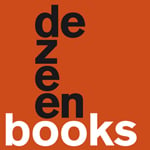
Buy this book at the Dezeenbooks store
(in association with amazon.co.uk)